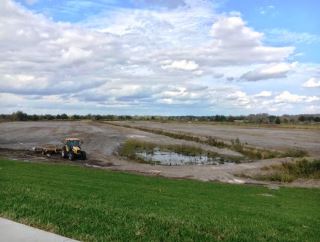|
Article Courtesy of The Tampa Bay
Times
By Alli Knothe
Published December 18, 2016
Wesley Chapel — After two years of holdups, workers have broken ground on a
7.5-acre pool called a Crystal Lagoon on old farmland a couple of miles east of
Interstate 75.
Contractors have cleared several acres of land off of Overpass and Curley roads.
The boomerang-shaped lagoon will be dug out over the next several weeks, and
concrete will start being poured in late January, said Metro Development Group
president Greg Singleton, the company behind the development.
|
The pool will be up to
eight feet deep, will be the length of five football fields and
will hold 16 million gallons of water. The typical 100-acre golf
course, by comparison, uses 78.9 million gallons of water in a
year, according to figures released by the U.S. Geological
Survey.
Previous coverage: Construction of giant Crystal Lagoon swimming
pool in Wesley Chapel to begin soon
The project was originally criticized for considering using
water pumped straight from the aquifer to fill the lagoon,
raising sinkhole concerns from nearby residents. Metro
Development then intended to purchase water from the county
utilities instead, though the developer has said it is reserving
the right to find another water source.
Utility officials said the
lagoon will be filled at a rate of 300 or 400 gallons a minute
over at least 30 days and cost Metro just over $50,000. |
|
|
Utility officials said the lagoon will be filled at a rate of 300 or 400 gallons
a minute over at least 30 days and cost Metro just over $50,000.
The U.S. Army Corps of Engineers and the Southwest Florida Water Management
District, commonly known as Swiftmud, have approved permits for the project.
The lagoon will be decked out with white sand, a plastic membrane lining and
hundreds of sensors and gadgets that help keep the pool clean.
Meanwhile, across the street, workers are laying the groundwork for the
residential area of the Epperson development, which will have about 1,500 homes.
The lagoon is the main amenity and centerpiece for that $100 million project and
will be maintained and managed with homeowners association fees. An underpass
intended for golf carts and autonomous, electric vehicles has also been built.
Epperson is expected be a part of the proposed Connected City district, an
ultrafast Internet community that will be the first of its kind in the nation,
developers say.
Another Crystal Lagoon is also being built in at Twin Creeks in St. John's
County. Uri Man, chief executive of Crystal Lagoon U.S., which licenses the
technology and concept to developers, said there are 50 lagoons in different
stages of development in the United States.
Epperson is just the first of Metro Development Group's planned lagoons in the
Tampa Bay area. In 2017, Singleton said they plan to start construction on
another roughly 8-acre lagoon as a part of a 2,500-home development on southern
Hillsborough County. Another is being planned for a 1,400-home project in north
Fort Myers.
Metro is even planning to build a fourth lagoon just up the street from the
Epperson project, on the northern portion of the Connected City development, on
the former Cannon Ranch. That one will be larger-- about 10 to 12 acres,
Singleton said.
Construction on the Epperson lagoon is expected to take about 12 months.
Crystal Lagoons was founded in 2007 by Fernando Fischmann, a real estate
developer with a biochemistry background who invested millions on a 20-acre
lagoon along the Chilean coastline in the mid 1990s. Fischmann spent five years
developing the technology that would keep this artificial body of water clean,
clear and economical.
With its patented technology, the lagoon has hundreds of sensors and small
injectors that add sanitizing chemicals when and where they are needed — a more
efficient strategy than a pool, which depends on a higher concentration of
chlorine to kill bacteria. If a child were to go to the bathroom in the lagoon,
the specific area would be treated with chlorine, leaving it neutralized in
minutes. If there is solid waste, the system is designed to make it clump
together so that a life guard or staffer can remove it with a skimmer.
Meanwhile, an ultrasonic filtration system helps remove the sand, dirt or other
materials that get dragged in.
|
